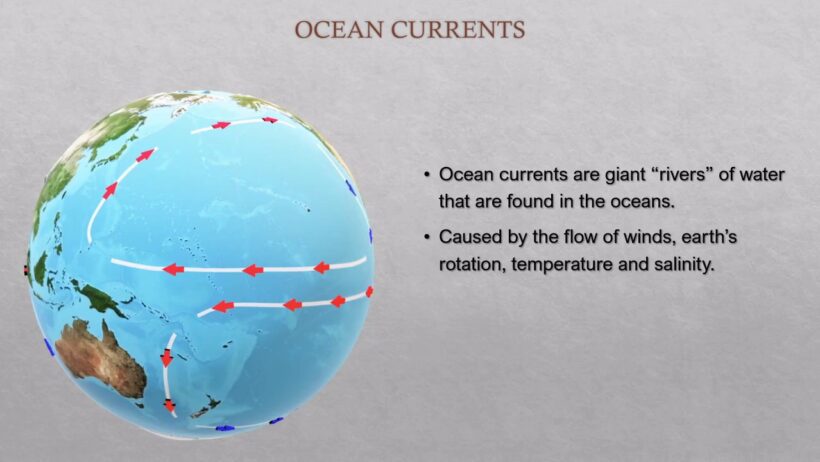Ocean currents, those vast flowing rivers within our seas, play a pivotal role in the Earth’s climate system. Their influence extends far beyond simple water movement; they affect weather patterns, climate fluctuations, and even ecological dynamics. Understanding the mechanisms by which ocean currents steer atmospheric conditions is essential for grasping the intricate relationship between the ocean and climate.
To appreciate how ocean currents influence climate, one must first understand what ocean currents are. These currents are the continuous, directed movements of seawater generated by various factors, including wind, salinity gradients, temperature differences, and the planet’s rotation. Ocean currents can be categorized into two primary types: surface currents and deep-water currents.
Surface currents, which dominate the upper 400 meters of the ocean, are primarily driven by atmospheric winds. The Coriolis effect, a result of the Earth’s rotation, causes these currents to flow in distinct gyres. For instance, the North Atlantic Gyre consists of the Gulf Stream, which transports warm water from the tropics toward the North Atlantic, significantly influencing the climate of nearby landmasses. The warmth carried by this current moderates the climate of Western Europe, making it markedly milder than other regions at similar latitudes.
Conversely, deep-water currents, often referred to as thermohaline circulation, arise from variations in temperature and salinity. These currents form in polar regions where cold, salty water sinks and begins a global conveyor belt, exchanging warm water from the equator with cold water from the poles. This process is critical in regulating global climate patterns, as it contributes to the distribution of heat across the planet.
One of the most profound impacts of ocean currents on climate is their role in regulating temperatures. They act as immense heat reservoirs, absorbing solar energy and redistributing it. Without this vital exchange, regions near the equator would become excessively warm, while polar areas could face uninhabitable temperatures. Furthermore, ocean currents dictate precipitation patterns by influencing the amount of moisture in the air. Warm currents facilitate evaporation, leading to increased humidity and rainfall in adjoining coastal regions, whereas cold currents tend to induce arid conditions.
The interplay between ocean currents and climate phenomena such as El Niño and La Niña exemplifies the significant weather implications of these currents. El Niño, characterized by the warming of surface waters in the central and eastern Pacific, can wreak havoc on weather patterns worldwide. It is associated with increased rainfall in some regions and drought in others. La Niña, the counterpart to El Niño, typically brings about cooler ocean temperatures and often results in opposite climatic conditions. These oscillations remind us of the ocean’s strength in shaping global weather patterns, underscoring the interconnectedness of oceanic and atmospheric systems.
Migration patterns of marine species, too, are influenced by ocean currents, illustrating how these currents can affect ecosystem dynamics. Species such as salmon and sea turtles depend on specific current patterns for their migratory journeys. Disruptions in these currents can lead to dislocation of marine populations, affecting biodiversity and the health of marine ecosystems. The implications of changing currents extend beyond marine life; they can have cascading effects on terrestrial life and human settlements that rely on these ecosystems.
As anthropogenic climate change progresses, the alterations in ocean currents are becoming increasingly significant. Changes in temperature and salinity due to glacial melting and increased freshwater influx from rivers can disrupt existing current systems, potentially leading to dramatic climatic shifts. Scientists warn of the impending consequences, which may include altered weather patterns, increased storm intensity, and unpredictable rainfall distribution. Such changes put millions of lives at risk, particularly in vulnerable coastal areas.
In addition to the physical alterations in ocean currents, there are socio-economic ramifications to consider. Fisheries, dependent on stable oceanographic conditions, may see declines in stock due to changed currents affecting fish populations. Coastal communities that rely on consistent weather patterns for agriculture and tourism may face economic hardships. These issues highlight the necessity for adaptive management strategies to mitigate the adverse effects of changing ocean currents and to safeguard both marine and terrestrial livelihoods.
Efforts to understand and predict changes in ocean currents underscore the importance of scientific research in our fight against climate change. Oceanographic studies utilizing sophisticated modeling and satellite observations provide critical insights into how ocean currents are evolving. Continued investment in climate science will enhance our ability to forecast potential changes, helping societies prepare for a future in which ocean currents will further dictate our climate destiny.
In summary, ocean currents are invaluable components of the Earth’s climate system, influencing temperatures, precipitation patterns, and ecological networks. Their complexities reveal a world steeped in interconnectivity, showcasing the need for a holistic approach to understanding climate dynamics. As we navigate the grave challenges of climate change, recognizing the integral role of ocean currents is essential. Their currents steer our weather, and thus, the sustainability of life on Earth hinges upon our ability to comprehend and respect these powerful maritime forces.







